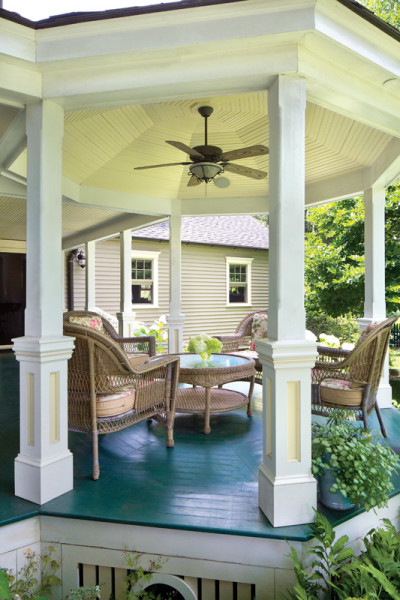
Paint (latex deck enamel) is used on floorboards of porch and pavilion at the Ticineto-Chase house. (Photo: Steve Gross & Susan Daley)
As the longtime owner of a wood home very close to the Atlantic Ocean, I am not the purist I once was. There was a time when composite materials would never cross my driveway, and three-coat primer-and-paint jobs were assumed. Here’s where I am today: High-quality composite lumber may be the best choice for unprotected decking; still, the floor of a covered porch—particularly an original front porch—should be made of wood.
While paint is still the premier finish for siding and many millwork components, a porch floor, even protected, is often better stained than painted. Whether your “weather” means freeze–thaw cycles, rain and high humidity, or strong ultra-violet exposure from the sun, any paint on exterior flooring will fail. (Meticulously applied paint on new wood, as in the photo, is an exception, but will still need maintenance.) Today’s exterior stains, easy to apply and re-apply, are formulated to resist mold and mildew; they penetrate to keep the wood from absorbing moisture.
If you’re dealing with strong sunlight, or if you prefer the look of paint, use an opaque (solid-color) stain. Because these heavily pigmented stains do form a film, they can peel. Nevertheless, they are easier to maintain, often needing only a power-wash before reapplication. As always, finish all surfaces, especially end-grain, and use two thin coats for best results.
PAINT
advantages
- Greatest number of color choices; deep color intensity
- Most formal and historical finish
- Greatest protection from UV and water
disadvantages
- Painted horizontal surfaces eventually peel, blister, or alligator
- Rapid weathering where water pools or ice collects, or with abrasion or UV exposure
- Must be thoroughly scraped, occasionally stripped or sanded, before recoating
STAINadvantages
- Finish options transparent to near-opaque
- Ease of application
- Permeable—so no blistering
- No need to strip before reapplication
disadvantages
- Needs reapplication frequently, every 1–5 years depending on exposure and opacity
- Cannot be used on previously painted wood







